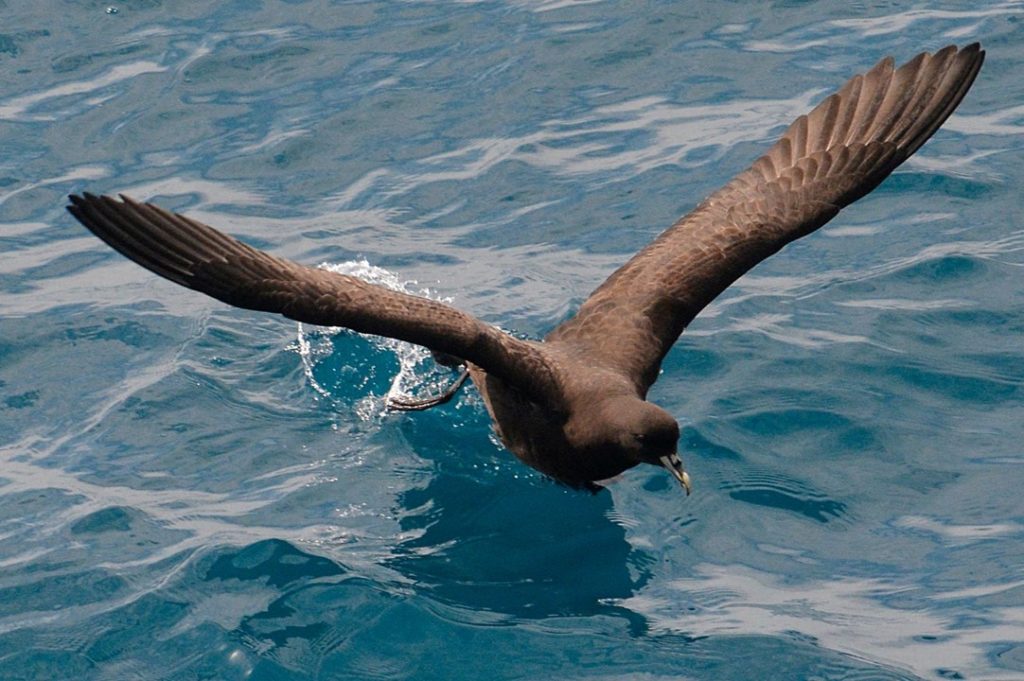© Paul F. Donald
Seabird Species
Large Petrels & Shearwaters
These species perform some of the longest trans-equatorial migrations across the oceans.
There are 30 shearwater species, 7 petrel species and 2 fulmar species in this group. The sizes vary greatly between species, from the tiny 25 cm long Little Shearwater to the 100 cm long Giant-petrel species. They are distributed throughout most of the world’s oceans and seas, with the seas north of New Zealand hosting the greatest amount of biodiversity of this group.
Like smaller albatrosses, these petrels make use of updrafts from waves to travel long distances with little effort.
Many of these species make long trans-equatorial migrations, for example the White-chinned Petrel migrates from its circumpolar breeding distribution northwards to subtropical waters during its non-breeding season. Most of this group are surface feeders, and flocks of birds such as the Wedge-tailed Shearwater are often associated with dolphin pods, which drive tuna fish towards the surface during their hunting, making prey accessible to the seabirds.
In The Seabird Tracking Database:
Spotlight species: White-chinned Petrel
The White-chinned Petrel (Procellaria aequinoctialis) is listed as Vulnerable by the IUCN, with accidental bycatch by longline fisheries contributing significantly. For example, Namibian hake longline fishery is thought to have resulted in the deaths of around 17,500 of this species during 2010 (BirdLife International 2017). The BirdLife Marine Programme has used tracking data to propose important areas where there are high numbers of White-chinned Petrels and has worked with the Namibian government to propose mitigations, such as bird-scaring lines, to reduce bycatch in such areas.
Please view this page on a desktop computer to see our interactive species colony map.
Tracked colonies of Large Petrels & Shearwaters
Use the map below to explore seabird colonies around the world.
Thanks to our data contributors: Akinori Takahashi; Amanda Freeman; Andre Raine; Andrew Westgate; April Hedd; Asuncion Ruiz ; Azwianewi Makhado; Ben Dilley; Ben Porter; Benjamin Metzger; BirdLife Malta; Cecilia Soldatini; Chris Powell; Daniel Oro; David Nicholls; David Thompson; Della G Bennet; Elizabeth Bell; Ellie Owen/RSPB; Ewan Wakefield; Fiona McDuie; Flavio Quintana; giacomo dell’omo; Giorgia Gaibani; Henri Weimerskirch; Ivan Ramirez; Jacob Gonzalez-Solis; Jacopo G. Cecere; Jaime Albino Ramos; Jaimie Cleeland; James Briskie; Jeroen Creuwels; John Arnould; John Quinn; Jose Manuel Arcos; Jose Pedro Granadeiro; Leandro Bugoni; Letizia Campioni; Maite Louzao; Maria Ana Dias; Maria Dias; Maria Magalhaes; Mark Andrew Hindell; Mark Jessopp; Matthieu Le Corre; Nicholas Carlile; Paul Sagar; Paul Thompson; Paulo Catry; Peter Ryan; Pierre Pistorius; Rachael Alderman; Raül Ramos; Richard Phillips/BAS; Robert Alfredo Ronconi; Robert Crawford; Rosemary Gales; Scott Shaffer; Susan Mary Waugh; Sven Kapelj; Takashi Yamamoto; Teresa Catry; Todd Landers; Trevor Glass; Veronica Rodrigues Costa Neves; Vitor Paiva; Wildlife Management International Ltd; William Montevecchi; Yuri Albores-Barajas
